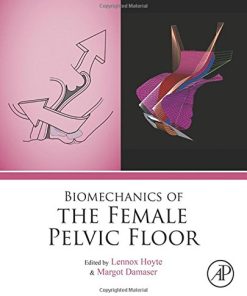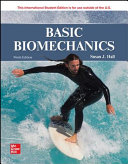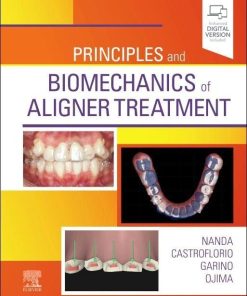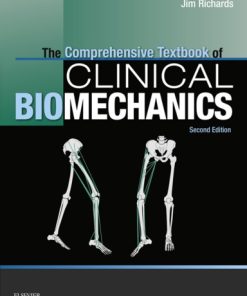(Ebook PDF) The World of Nano Biomechanics Second Edition by Atsushi Ikai ISBN 9780444636874 0444636870 full chapters
$50.00 Original price was: $50.00.$25.00Current price is: $25.00.
(Ebook PDF) The World of Nano Biomechanics Second Edition by Atsushi Ikai -Ebook PDF Instant Download/Delivery: 9780444636874, 0444636870
Instant download Full Chapter of The World of Nano Biomechanics Second Edition after payment

Product details:
ISBN 10: 0444636870
ISBN 13: 9780444636874
Author: Atsushi Ikai
The World of Nano-Biomechanics, Second Edition, focuses on the remarkable progress in the application of force spectroscopy to molecular and cellular biology that has occurred since the book’s first edition in 2008. The initial excitement of seeing and touching a single molecule of protein/DNA is now culminating in the development of various ways to manipulate molecules and cells almost at our fingertips, enabling live cell operations.
Topics include the development of molecular biosensors, mechanical diagnosis, cellular-level wound healing, and a look into the advances that have been made in our understanding of the significance of mechanical rigidity/flexibility of protein/DNA structure for the manifestation of biological activities.
The book begins with a summary of the results of basic mechanics to help readers who are unfamiliar with engineering mechanics. Then, representative results obtained on biological macromolecules and structures, such as proteins, DNA, RNA, polysaccharides, lipid membranes, subcellular organelles, and live cells are discussed. New to this second edition are recent developments in three important applications, i.e., advanced AFM-data analysis, high-resolution mechanical biosensing, and the use of cell mechanics for medical diagnosis.
Table of contents:
- Chapter One. Force in Biology
- 1.1. What Are We Made Of?
- 1.2. Human Body and Force
- 1.3. Macroscopic Biomechanics
- 1.4. Molecular Basis for Structural Design
- 1.5. Soft Versus Hard Materials
- 1.6. Biological and Biomimetic Structural Materials
- 1.7. Thermodynamics and Mechanics in Nanometer-scale Biology
- Chapter Two. Introduction to Basic Mechanics
- 2.1. Elastic and Plastic Deformation of Materials
- 2.2. Stress and Strain Relationship
- 2.3. Mechanical Breakdown of Materials
- 2.4. Viscoelasticity
- 2.5. Fluid and Viscosity
- 2.6. Adhesion and Friction
- 2.7. Wear and Tear of Biological Structures
- 2.8. Mechanically Controlled Systems
- Chapter Three. Force Measurement and Mechanical Imaging Apparatuses
- 3.1. Mechanical, Thermal, and Chemical Forces
- 3.2. Laser Trap
- 3.3. Atomic Force Microscope
- 3.4. Surface Force Apparatus
- 3.5. Biomembrane Force Probe
- 3.6. Magnetic Beads
- 3.7. Gel Columns
- 3.8. Cantilever Force Sensors
- 3.9. Loading-Rate Dependence
- 3.10. Force Clamp Method
- 3.11. Specific Versus Nonspecific Forces
- Chapter Four. Interaction Forces
- 4.1. Covalent Versus Noncovalent Bonds
- 4.2. Basics of Electrostatic Interaction
- 4.3. Various Types of Noncovalent Interactions
- 4.4. Application of External Force
- 4.5. Interaction Force Between Macromolecules
- 4.6. Water at the Interface
- Chapter Five. Polymer Chain Mechanics
- 5.1. Polymers in the Biological World
- 5.2. Polymer Chains
- 5.3. End-to-End Distance
- 5.4. Persistence Length
- 5.5. Polymers in Solution
- 5.6. Polymers on the Surface
- 5.7. Polymers As Biomimetic Materials
- 5.8. Polymer Pullout
- Chapter Six. Analysis of Data Gleaned by Atomic-Force Microscopy
- 6.1. Introduction
- 6.2. General Processing of Topographic AFM Images
- 6.3. Specimen-Specific Analysis Procedures
- 6.4. Processing of Force Spectroscopy Data
- 6.5. Conclusions
- Chapter Seven. Single–Molecular Interaction
- 7.1. Ligand–Receptor Interactions
- 7.2. Sugar–Lectin Interactions
- 7.3. Antigen–Antibody Interactions
- 7.4. GroEL and Unfolded-Protein Interactions
- 7.5. Lipid–Protein Interactions
- 7.6. Anchoring Force of Proteins to the Membrane
- 7.7. Receptor Mapping
- 7.8. Protein Unanchoring and Identification
- 7.9. Membrane Breaking
- Chapter Eight. Single-Molecule DNA and RNA Mechanics
- 8.1. Stretching of Double-Stranded DNA
- 8.2. Unzipping of dsDNA
- 8.3. Chain Dynamics and Transition of DNA and RNA
- 8.4. DNA–Protein Interaction
- 8.5. DNA Machine
- 8.6. Prospect for Sequence Analysis
- Chapter Nine. Single-Molecule Protein Mechanics
- 9.1. Introduction to Protein Manipulation
- 9.2. Protein-Stretching Experiments
- 9.3. Intramolecular Cores
- 9.4. Stretching of Modular Proteins
- 9.5. Dynamic Stretching
- 9.6. Catch Bonds
- 9.7. Protein-Compression Experiments
- 9.8. Internal Mechanics of Protein Molecules
- 9.9. Mechanical Control of Protein Activity
- 9.10. Computer Simulation of Protein Deformation
- 9.11. Case Studies: Proteins and Polypeptides of Notable Structural Characteristics
- Chapter Ten. Nanomechanics of Motion-Supporting Molecular Systems
- 10.1. Cell Movement and Structural Proteins
- 10.2. Muscle and Motor Proteins
- 10.3. Single Molecule/Filament Measurements
- 10.4. Flagella for Bacterial Locomotion
- 10.5. Mycoplasma Gliding
- 10.6. Mechanics and Efficiency of Motor Proteins
- 10.7. Video View of Motor Proteins in Action by High-Speed AFM
- Chapter Eleven. Finite-Element Analysis of Microbiological Structures
- 11.1. Introduction
- 11.2. A Brief History of the Finite-Element Method
- 11.3. The Finite-Element Method
- 11.4. Application of the Finite-Element Method to Microbiological Structures
- 11.5. Conclusions
- Chapter Twelve. Nanomechanical Bases of Cell Structure
- 12.1. Red Blood Cell: Model Cell in Biomechanics
- 12.2. Helfrich Theory of Membrane Mechanics
- 12.3. Deformation of 2D Membrane
- 12.4. Membrane and Cytoskeleton
- 12.5. Association of Membrane Proteins With Cytoskeleton
- 12.6. Nano-Indentation Experiments on Live Cells
- 12.7. Stiffness Tomography and Cell Response Studies
- Chapter Thirteen. Nanorheology of Living Cells
- 13.1. Cell Rheology
- 13.2. AFM Measurements of Cell Modulus
- 13.3. High-Throughput Measurements of Cell Rheological Properties
- 13.4. Elastic Modulus of Normal and Cancer Cells
- 13.5. AFM Imaging Mode for Measuring Viscoelastic Properties of Cells
- Chapter Fourteen. Molecular and Cellular Manipulations for Future Nanomedicine
- 14.1. Prospects for Useful Applications for Nanomedicine
- 14.2. Bioconjugation of Materials
- 14.3. Nanomechanical Manipulation of Cells Aiming at Nanomedical Applications
- 14.4. Cell Surgery
- 14.5. Chromosomal Surgery and Gene Manipulation
- 14.6. Tissue Surgery
- 14.7. Liposomal Technology
- 14.8. Drug Delivery
- 14.9. DNA and RNA Recovery From the Chromosome and the Cell
- 14.10. Wound Healing
- Appendix One. Beam Bending
- Appendix Two. V-Shaped Cantilever
- Appendix Three. Persistence Length Versus Kuhn Length
- Appendix Four. Hertz Model
- Appendix Five. Derivation of the Loading-Rate Dependence of the Mean Rupture Force
People also search:
the nanobots
the future of nanotechnology in medicine
biotechnology science for the new millennium second edition pdf
e=mc2 a biography of the world’s most famous equation pdf
nanobots 2030
Tags:
Atsushi Ikai,Nano Biomechanics,World
You may also like…
Science (General)
Science (General) - Theories of Science
Uncategorized
Uncategorized
Medicine - Anatomy and physiology
The Comprehensive Textbook of Clinical Biomechanics 2nd Edition Jim Richards












